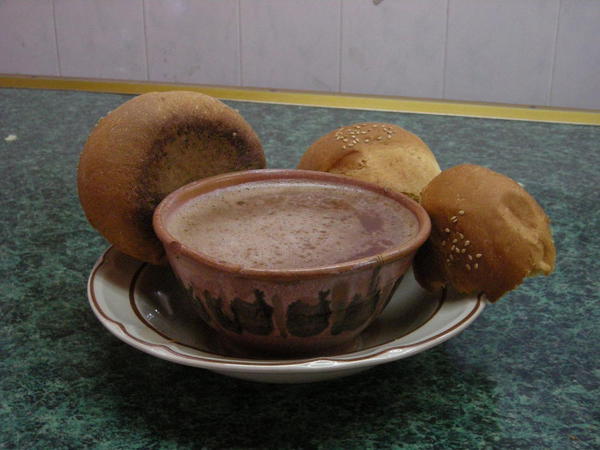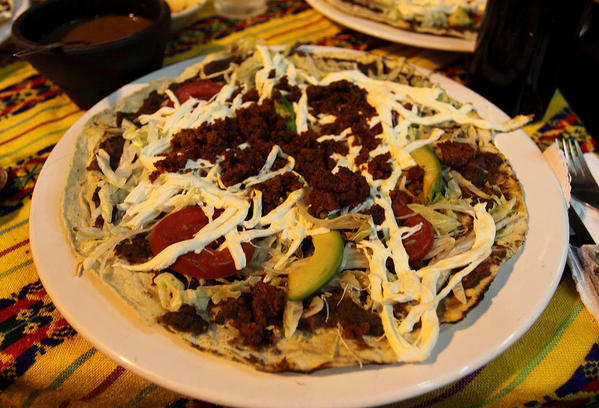In a word, food. More on the subject later.
I’ve lived most of my life between 10 and 500 miles from Mexico. For 24 years my house was 10 miles from the port of entry at Naco, Arizona/Sonora, in Bisbee, 1988 to 2012. Going to Mexico was something we did for lunch, before Homeland Security and Border Patrol took over the countryside. We drove down for items not available on the north side, like ceviche and caldo de queso, a block after crossing, freshly-baked rolls and a better brand of salsa than Safeway’s at a little grocery store one more block from the Line. And most popular of all, the farmacia, where friends bought their prescription medicines for a fraction of the price and a doctor steps away to facilitate the process. And dentists, in Naco and A.P. (Agua Prieta, 25 miles away), for many of my artist friends with no money for such things at the prices charged on our own side.
On one foray beyond the border towns, a friend and I signed up for a day trip organized by the local community college. We ventured south of the familiar, to several farm villages and a bigger town with a mission famous locally for the tomb of a beloved padre. We stopped for a lunch that bore little resemblance to what most Americans think of as Mexican food, at the creekside home of a hospitable lady and ate on outdoor tables. I climbed the bell tower of the church and looked down on the rural landscape, so utterly different from the Estados Unidos, just an hour north.
I listened to tales of friends’ time spent farther south, in Rocky Point/Puerto Peñasco and Guaymas. Then conversations with more upscale acquaintances with their own plane and a house in Alamos, Sonora. Years went by and finally I decided, with my S.O. lingering indefinitely in Brazil, to spend a week over the Christmas holiday in Alamos. I bought a fat copy of Lonely Planet Mexico, went to Alamos and enjoyed it and then ignored our neighbor country again for years. I opened LP occasionally, thinking about places I might like to go and did nothing about it. The footpaths in England and tribal villages in Asia beckoned more insistently.
I think travel can be as much an addiction as any compulsive behavior and I nurtured my habit in spades. Then my move home to California exhausted me and for many months I could hardly do anything, let alone summon the energy to even think of going much farther than the grocery store. It became de facto cold turkey where travel was concerned. I'd broken the habit and there was nothing wrong with that, I thought sometimes. When I started reaching for the guidebooks again I thought maybe I’d arrived at the moment when I could consider being a social traveler, rather than an addicted one. For months I tried on various possibilities, picked up ‘Mexico’ then put it back. At some point I opened it again and went to the Oaxaca chapter. Interested, I then checked the publication date and saw the stain on the edges of the pages from when I’d dropped my brand new book in a puddle in a parking lot in Sierra Vista, Arizona, a decade before. It was time for a new one.
I got my new fat guidebook, but Mexico is a big country and I checked Amazon for something more focused. I bought Moon Guide’s Oaxaca Valley. And then I started reading online and the wealth of experiences waiting for me, including Oaxacan regional cuisine beyond mole, began to be apparent. And as I read, despite having a smattering of the language with more food words than anything else, I realized I was clueless. Back to Amazon and 2 more books ordered, both on Mexican food vocabulary. I intend to put my new knowledge of Spanish fully to use.
A couple of weeks later, I had 3 new, used books, the 2 food ones and another strictly Oaxaca guide I spotted on Amazon. The small food books arrived together from the same seller, and the first thing I noticed was, paper fetishist that I am, one was acid-free paper, one was not. This means that while one has clean white pages, the other is yellowing. If it was badly yellowed, I’d likely give it away. But it isn’t bad so I’ll compare the 2 and bring along the one that seems easiest to use. Both are about the same size, similar to a travel-sized dictionary.
The third book is from a series called Great Destinations Mexico, Oaxaca, by Paige R. Penland. I had a look through it as soon as I unwrapped it from its mailer and was immediately impressed. Considerably larger than the Moon Guide, in all dimensions, it seems to have so much more information that it may very well justify the added weight, should it land in my suitcase. There are 5 pages of museums and libraries alone and I’ll continue looking but I think this is the one. It is, I think, a guide written by someone who knows her subject and cares that her audience benefits from that knowledge, in contrast to so many guides written by committee and published, then republished, with only the bottom line in mind. This one seems to be something else.
Back to food. Mole. There’s a tradition in Oaxaca called the 7 Moles, although to date I’ve only eaten the most famous, called mole negro. I remember my first taste of “black” mole. I’d just arrived in Bisbee and a friend suggested we walk across the line and take a bus to Cananea, a sort of wild west Mexican mining town about an hour south. We stopped for lunch soon after we arrived and I asked Glenn to help me with the menu. What’s mole? I’d never heard of it and afterward I’d never forget it. I have to say, in some circles a good mole is considered better than good sex, and after I started my research and realized that Oaxaca is Mole Mecca, I didn’t think nearly as much about going anywhere else.
I have, of course, compiled a list of recommended places to eat, mole and otherwise, none of them upscale tourist establishments, which I eschew (just noticed “chew” in “eschew") for a variety of reasons. I will certainly report my experiences, none of which my intuition tells me, will be bad.
There are other reasons I settled on Oaxaca as a destination, to be sure. There are a number of markets in the heart of the city. And once-a-week food and crafts market days in a number of villages of indigenous people in the surrounding countryside. I’d go a long way for markets alone.
Mexico is cheap, and while cheap isn’t reason enough, when it’s a place that looks beautiful, has great food, welcoming people and it’s affordable as well, that constitutes encouragement in my book. My very new-looking ensuite room in a 400 year old colonial-era house with a courtyard for sitting, 3 blocks from the Zocalo, the main square in the center of the colonial heart of the city, will set me back $400 US for 3 weeks, or $20 a night (there has since been a modest increase) .
Oaxaca is a complete change of direction for me, literally. My focus for a number of years has been to the east of home, to Europe and North Africa, and to the west, to Asia. I’m excited to be turning south now, in the direction I’ve long felt I’ve neglected but might love, if only I felt called. I’ve never been intellectually drawn to destinations, but have gone where I’ve been moved to go for emotional or esthetic reasons. I don’t recall ever having been wrong identifying places in this way and I’m feeling very happy now thinking about Oaxaca.
Photos courtesy of Wikipedia.org
Oaxaca City, Oaxaca:
Population 260,000 (big enough & small enough)
Elevation 1550 m/5000 ft (nice & high, but not too high)
Next week: Planning begins in earnest.
Click here for links to all episodes of 'Anatomy of a Trip: Oaxaca'
To others more of PortMoresby’s contributions, click here.





Comments (1)